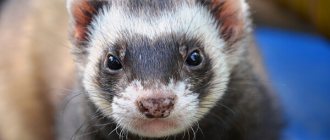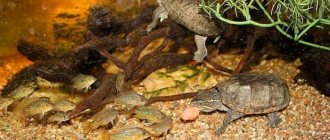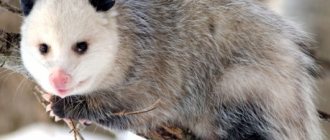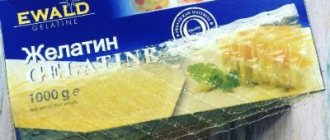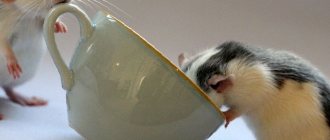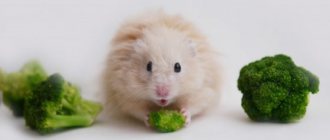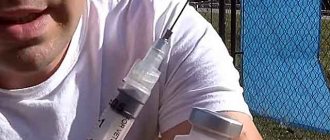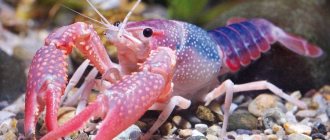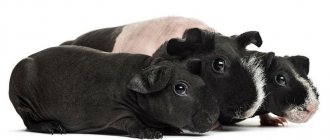Feeding ferrets in nature
Ferrets are solitary hunters by nature. In the wild, these animals are predators and feed on rodents. The diet of ferrets consists of hamsters, ground squirrels, rabbits, field mice, rats, and gerbils. Ferrets easily catch lizards, frogs, and hunt poisonous snakes.
These animals have the ability to silently sneak up, ferrets attack hazel grouse, destroy bird nests on the ground in order to eat chicks and eggs. Ferrets' favorite delicacy is hedgehogs; their thorns do not frighten ferrets at all; they eat hedgehogs with great pleasure.
Natural diet of ferrets
Their habitat is represented mainly by forest areas: they have chosen the edges of forests bordering reservoirs.
Ferret in the wild
They live in makeshift burrows, and the entrance to their home is often located under an old stump. They spend most of the daytime at the “front door” in the bush, where it is quite difficult to see them. Their peak activity occurs after sunset and in the predawn hours. In winter, the nocturnal predator gains weight up to 2.5 kg, and by summer it loses weight significantly. It reaches a length of about 0.5 m, and its life span in natural conditions is about 6 years.
In the wild, he feasts on whatever he can catch. The ferret eats almost no plants; its diet consists mainly of food of animal origin: small rodents, moles, shrews and voles. It does not disdain amphibians: it happily feeds on lizards, frogs, newts and other creeping reptiles. He prefers hedgehog meat as a delicacy. Despite the prickly needles of this insectivore, the animal fearlessly attacks the animal. Sometimes the ferret destroys bird nests in search of small chicks. If given the opportunity, he will easily catch a muskrat or even a hare!
Ferrets are incredible hunters
They are excellent hunters with incredible instincts and intuition. They are able to sneak up on the victim so silently that sometimes such timid and sensitive birds as black grouse and hazel grouse fall into its clutches. This animal cannot be frightened even by a snake, regardless of whether it is a poisonous viper or a harmless snake. He can also catch large insects.
When running into village settlements, he does not hesitate to pamper himself with local chicken or goose, depending on the existing options, and in order to satisfy his hunger, one individual is often not enough for him.
Ferrets are famous for their habit of saving food for a rainy day. No matter how well-fed he is, he will continue hunting until he makes a solid supply of provisions, hidden in a place hidden from prying eyes.
In the warm season, Mother Nature is favorable to the inhabitants of the forest, providing them with food in large quantities. However, with the onset of cold weather - the time when the bunnies have matured, the chicks have grown, and the frogs have fallen into suspended animation until better times come, the list of “products” is significantly reduced. But even in this situation, born hunters have learned to survive: their excellent sense of smell helps them find prey located under a deep layer of snow. Rats, mice, hazel grouse hiding at night and other birds - no one escapes their watchful eye.
Ferret diet plan
When keeping ferrets, special attention should be paid to nutrition. After all, an incorrectly selected diet has a negative impact on health. Thanks to the wide variety of options, each breeder can choose the appropriate nutrition plan for himself.
Natural food
From natural products, ferrets are given meat - chicken or turkey, raw, with cartilage and bones, with the exception of tubular ones, and other offal. Breeders add dairy products other than milk to the diet because these animals are lactose intolerant.
Be careful with the fish. Not every type of fish is suitable for ferrets; animals are allowed to be given shrimp, squid, red fish - salmon, trout, but in small quantities.
Natural food should not be boiled; food should be given raw or defrosted.
Dry snacks
Food for ferrets, the ingredients of which include poultry meat containing easily digestible protein of non-vegetable origin - these are snacks. Currently, the market offers dry food, the composition of which was developed by specialists specifically for ferrets. The protein content in dry food is 32-36%, carbohydrates, fats - no more than 20%, up to 5% plant fibers.
In the absence of special food, you can purchase premium food for kittens and pregnant cats. Dog food is absolutely not suitable.
When feeding on dry food, your ferret drinks a lot of liquid, so you need to constantly ensure that the sippy cup is always filled with water.
Live food
Eating live food gives ferrets great pleasure. After all, by choosing such a scheme, breeders get as close as possible to the natural nutrition of these animals in nature.
The following are suitable live food, which is sold in veterinary pharmacies:
- mice;
- chickens;
- mealworms;
- marble cockroaches.
Treats
From time to time the ferrets are given various treats. Ferrets will eagerly eat cheese, cottage cheese, baby kefir and quail eggs, which can be present in the diet once a week. Pieces of fruit are allowed as treats, because ferrets really love apples, bananas, and pears.
Choose your ferrets' treats wisely; don't please them with treats from your table, as this will only cause harm. Indeed, in nature, plant food enters the body of these animals only if it is inside the caught prey.
Vitamins and supplements
For proper development and growth, ferrets need to be given vitamins and minerals. They are part of ready-made additives, which come in two types:
- vitamin pastes;
- vitamin complexes.
Pastes and complexes can be given to ferrets separately or added to food.
Vitamin paste helps animals recover faster, recover and regain strength after undergoing operations. Vitamin complexes are given to ferrets all year round, the dosage varies depending on the season, and the age of the animal is also taken into account.
The vitamins and minerals included in the supplements are important during shedding, lactation and estrus. The additives contain:
- minerals – calcium, phosphorus, magnesium, iron;
- A, E, D and other vitamins;
- Brewer's yeast.
Before choosing a vitamin supplement, be sure to consult a specialist.
Diet of a domestic ferret: a complete list of allowed foods
Since the ferret is a prime example of a predatory animal, it is necessary to treat it, first of all, with meat.
Since ferrets are carnivores, they prefer meat
The basis for its gastronomic delights are chicken or turkey meat and lean veal. Due to the fact that beef and pork are less digestible, it is not recommended to offer this meat to your ferret. To make your diet more varied, you can include fish products in your diet. The animal happily eats both cod and herring. Trout, mackerel and other tasty bug-eyed species are also suitable.
In its natural habitat, the ferret eats its prey entirely. In this regard, it is recommended to include tough meat in home meals, leaving bones and cartilage. With great pleasure he will feast on a chicken neck or head. But it’s better to refrain from eating legs: they consist of tubular bones, and poorly chewed pieces can injure your pet’s gastrointestinal tract.
A well-designed diet is a guarantee of health and longevity for any creature on the planet. Ferrets have a fast metabolism, which requires a particularly careful approach to feeding them. Even the most minor mistakes can lead to serious illnesses.
Water for ferrets
List of recommended products
Being in the wild, ferrets are surprisingly stable in their choice of main “dishes”.
Domestic ferrets
Individuals living in conditions of increased home comfort are not so far removed from their predatory ancestors.
The nutrients they need daily are found in the following foods:
| Meat | Seafood | Eggs | Sub products | Porridge | Fruit and berry | Vegetables | Dried fruits | Greenery | Live food |
| mutton | flounder | quail | liver | Pearl barley | persimmon | pumpkin | figs | parsley | mice |
| horsemeat | mackerel | chicken | chicken giblets | rice | banana | tomatoes | raisin | scalded nettle | insects |
| beef | herring | heart | buckwheat | apple | zucchini | dates | dill | worms | |
| turkey | cod | kidneys | wheat | strawberry | cucumber | dried apricots | chickens | ||
| chicken | trout | pear | broccoli | prunes | |||||
| quail | shellfish | watermelon | Bell pepper | ||||||
| crustaceans | melon | radish | |||||||
| cherry | |||||||||
| grape | |||||||||
| cherries |
From fermented milk products, you can offer the animal kefir, sour cream, fermented baked milk or low-fat cottage cheese, and among dry food, the favorites are Acana, Frettchen4you, James Wellbloved Ferret Complete and Bosch Totally Ferret. When preparing your daily diet, you should remember to maintain a balance between the products used.
Farshekashi recipes
Farshekasha is a mixture that is often used to feed ferrets. It may contain several ingredients.
Recipe No. 1
Designed for young puppies and growing individuals. The composition of farshekashi includes:
- chicken stomachs – 1 kg;
- chicken necks – 2 kg;
- rice or buckwheat groats – 400 g.
The breeder presented the recipe for farshekashi in his video below:
Preparing farshekash is very simple:
- Grind the cereal into flour, then cook until completely cooked.
- Grind the offal into minced meat, which is mixed with the finished porridge.
- Add vitamins in the required quantities to the minced meat.
Recipe No. 2
This recipe is prepared for adult animals. Farshekasha consists of the following components:
- cottage cheese – 60 g;
- fish – 150 g;
- beef heart – 100 g;
- chicken meat – 0.5 kg;
- rice – 100 g;
- poultry fat – 10 g.
The cooking process is very simple:
- Cook the rice for 2-3 hours, grind the remaining ingredients into minced meat.
- Mix the resulting minced meat with porridge, add the necessary vitamins.
- Divide the finished minced meat into portions and place in the freezer.
How to water ferrets
Ferrets are natural carnivores, so they eat large amounts of meat. Ferrets' mouthparts are designed for biting, tearing and chewing. The animal's jaw is capable of breaking bone into small particles.
Ferrets are carnivorous animals and the basis of their diet is meat.
The digestive organs of ferrets have the following features:
- Stomach size 20 ml.
- Short digestive tract – 2 m.
- The large intestine has the simplest microflora.
- The cecum does not perform any functions.
Food in an animal’s body is digested in an average of 6 hours. The animal's saliva does not contain amylase, which breaks down polysaccharides.
Taking into account all of the above, the basis of the ferret’s menu should be fast-digesting products that can provide the body with all the necessary nutrients in a short time.
Greens and vegetables in a ferret’s diet are no more than 10%
Quail eggs are better for ferrets than chicken eggs
For a domestic ferret, such food will be a real delicacy, but not all owners have the opportunity to provide their pet with a regular supply of live food.
One of the main components vital for ferrets is taurine, which improves the functioning of the brain, heart muscle and liver. This amino acid is found in poultry meat.
Ideally, a ferret's diet should contain:
- Animal protein – 60%.
- Fats – 30%.
- Carbohydrates – 10%.
Your pet's feeder should always be filled. Animals love to chew something throughout the day, so you shouldn’t feed them on a strict schedule.
It is better if the ferret eats 7 to 10 times a day in small portions.
The breeder decides what to feed the ferret at home based on his capabilities.
Ferrets drink a lot of liquids, so it is important to provide them with a constant source of clean water at room temperature. In the feeding area it is better to install two drinking bowls with automatic drinking
Your pet will not knock over the bowl if you use heavy dishes. The cleanliness of drinking bowls must also be carefully monitored.
If possible, you can arrange a small fountain in the cage; the ferret will splash around in it with pleasure.
Chicken for the predator
The ferret eats mostly only food of animal origin.
In the wild, these are small birds, carrion and sometimes fish and eggs.
Despite its small size, the animal is not a rodent, as many people think, but a real predator.
Therefore, when getting him, you should take into account his character and food preferences. A ferret at home also needs a balanced and proper diet.
The best way to understand what ferrets eat is to learn about the lives of their closest wild relatives in their natural habitat. Our heroes' relatives include stoats, weasels and minks, all of which form the beautiful but predatory family of mustelids. There are steppe and forest ferrets, whose habitat extends from Siberia to Central Europe, and the American black-footed ferret, which lives in the vastness of the USA and Canada.
Even the largest steppe species of animals does not exceed 56 cm in length, so it is not surprising that ferrets in nature love to eat mainly small animals - gophers, spittle, rats, mice, toads, ducks, young hares, rabbits, large species of insects. Domesticated ferrets come from forest ferrets, the body length of these animals is up to 51 cm, they were mainly bred to exterminate harmful rodents.
Ferrets are fed mainly with products that contain a large percentage of valuable protein and with a small amount of grain components. For this reason, it is not recommended to buy dog food, but grain-free cat diets are good for our pets. It is advisable to avoid economy class food; they contain a huge percentage of grains and potatoes.
What you should not give ferrets to eat:
- milk;
- sour cream;
- pork;
- sausage;
- smoked and fried meat;
- dishes with spices;
- citrus;
- flour products;
- candies;
- grape;
- dried apricots;
- figs;
- spices;
- mushrooms;
- nuts;
- onion;
- garlic;
- salty food;
- soy products.
Features of feeding in different periods
The diet of ferrets becomes special at certain periods of life. What remains common is the obligatory presence of minerals and vitamins.
Growth period
During breastfeeding, young ferrets receive the nutrients their bodies need through their mother's milk. Deprived of mother's milk, ferrets' gastrointestinal tract becomes vulnerable to infections, which is why probiotics should be kept in the breeder's medicine cabinet at all times.
Ferrets are transferred to “adult” feeding 3-4 weeks after birth. At this time, their baby teeth begin to erupt. In order for babies to quickly get used to this diet, liquid minced meat is introduced into the diet, and low-fat cream or baby kefir is added to the mother’s menu.
Don’t forget about vitamins - 3-4 drops of fish oil are dripped onto the tongue of ferrets. If more male furos were born in the litter, more calcium and phosphorus are added to the food, since males are more active.
Don't forget to give your pets vitamin pastes and supplements. Lack of nutrients negatively affects the growth and further development of ferrets.
Shedding period
Furo molt in early spring and autumn, with the exception of pregnant females who shed on the 20th day of pregnancy, and animals that have suffered a hormonal imbalance. Shedding lasts 1-2 weeks and is accompanied by severe itching. In some areas of the body there is practically no hair.
Ferrets are very clean, so they carefully lick themselves, as a result of which a lot of hair gets into the gastrointestinal tract and vomiting begins. To prevent this from happening, the animals are given fur-removing pastes. Pets are helped to cope with shedding by combing their fur with a brush or using a furminator.
During molting, ferrets need vitamin complexes containing sulfur, brewer's yeast and B vitamins. Thanks to which the new fur will be thick and shiny.
Pregnancy period
In order for the offspring to be born healthy, a pregnant female is given an individual diet.
The menu of a pregnant female must contain:
- phosphorus, calcium for strong teeth and bones;
- vitamins A, E, D and group B - in increased quantities.
When feeding chorihi with natural food, the menu includes meat and bone meal, calcined cottage cheese, and fish oil. If the female eats dry snacks, she is given special food for pregnant women or a product intended for cats. You can’t overfeed a choriha – this leads to obesity, but limiting the female’s nutrition is also dangerous.
Before childbirth and in the first days after it, the chorikha's appetite worsens. The ferret's menu during lactation is identical to the diet during pregnancy. Nutrient requirements are still high.
What to feed correctly?
The best diet for a domestic ferret is rodents, but additionally keeping cages with mice is expensive, and there are also problems with the moral and ethical side.
Products that form the basis of the diet:
- meat (beef, horse meat, lamb) is rich in protein, has high nutritional value, contains many B-group vitamins, as well as iron and phosphorus. The main disadvantage is the high cost. The ferret eats better raw; boiled meat should be included in the diet for gastroenteritis during treatment;
- liver and spleen should be the main food, especially for pregnant females and during the rutting period. The main value is the huge content of vitamins and microelements, as well as excellent nutritional value;
- heart and kidneys are rich in protein and contain many vitamins B and A;
- tripe - cheap food, but with low nutritional value;
- fish – given only defrosted. Its nutritional value is similar to that of meat. By eating it with bones, the ferret provides itself with calcium;
- Cottage cheese is a valuable protein product, also rich in fat, calcium and other substances.
Feed provided in limited quantities:
- milk, as it has a laxative effect;
- lungs – low nutritional value, provoke the development of a gag reflex;
- chicken heads, legs - crushed bones are ballast substances and are needed to improve digestion;
- eggs;
- currant and rowan berries – improve intestinal motility in ferrets;
- carrots, cabbage, green salad. They are given in crushed form mixed with minced meat;
- oatmeal, millet, barley porridge. No more than 20% of the total diet is given.
It is better to feed your ferret at home separately and several times.
Features of feeding pregnant ferrets and females with puppies
At the beginning of pregnancy, the diet does not change, but starting from the middle, the volume of feed should be reduced by 20-30%, while increasing the nutritional value and vitamin content. To do this, reduce the amount of porridge or eliminate it altogether. The content of liver, meat and fish in the diet should be increased.
The most important thing during this period is not to overfeed the female ferret.
Obesity during pregnancy leads to weak labor and the birth of a non-viable litter. If your pet is above average in body fat, then the basis of the diet should be low-fat fish, and it is better to increase the concentration of vitamins with supplements or injections. In the last days before whelping, it is necessary to provide the female with water - due to increasing thirst, the offspring may be eaten.
Water should also be provided ad libitum during the feeding period to enhance milk production. Cottage cheese has milk-containing properties, the proportion of which must be increased. At this time, a lot of energy is required, so the nutritional value of food should be 2 times higher compared to the usual diet.
How to feed a small ferret?
The first problem is taming the baby to a certain feeding place. To prevent him from dragging pieces around the house and hiding pieces, it is better to make a semi-liquid mixture:
- chopped meat;
- chopped fish;
- chopped vegetables;
- bouillon.
After a week and as the puppy gets used to it, it will become accustomed to one feeding place. At this time, you need to pay special attention to mineral nutrition, especially phosphorus and calcium. For this, the main diet should be fresh frozen fish - more than 30%. You should not give eggs, especially raw ones - the substance they contain blocks biotin, which is responsible for normal growth and development.
How to choose dry food?
Before choosing dry food, be sure to read what components are listed in the composition. It is worth paying attention to the following points:
- Poultry meat should be listed first; if it is premium food, then there may be two types of meat.
- The content of plant fibers should be no more than 3-5%, since furo is difficult to digest fiber.
- The percentage of ash should not exceed 7%, otherwise the pet runs the risk of developing urolithiasis.
- The food should contain the amino acid taurine, which is good for the heart and eyes.
- It's best to avoid foods that contain cornmeal, especially if it's listed first.
What is dangerous to feed?
Not only plant foods in large quantities are harmful to these pets. Many components we are familiar with pose a danger to ferrets.
| Dangerous and harmful foods for ferrets | |
| Type of feed: | Cause: |
| pork | possibility of infection with Aujeszky's disease, used only in boiled form |
| chicken by-products | When raising poultry, hormonal drugs and antibiotics are used, which accumulate in the internal organs |
| raw fish | the presence of parasites, such as diphyllobothrium, can only be used after freezing |
| boiled bones, boiled meat with bones | cooked bones are not digested, but are destroyed in the intestines into sand, causing coprostasis |
| sour milk | Causes stomach upset in ferrets |
| Rye flour | may cause intestinal dysfunction |
| sugar, sweets | insulinoma, gastroenteritis |
| dog food | high content of plant components in any class |
What should you not give to ferrets?
There is a whole list of foods that should not be given to ferrets.
| Products | Why not? |
| Pork, lamb | These are fatty meats and are difficult to digest. |
| Pike, bream, pollock, herring, hake | The listed products contain trimethylamine oxide and thiaminase, which interfere with the absorption of vitamin B1. |
| Milk | This product is not digestible and loose stools may occur. |
| Citrus | Allergen, possible itching and rash. |
| Nuts | They are difficult to digest and can cause stomach blockage. |
What not to do
It is strictly forbidden to feed your ferret the following foods:
- fat meat;
- spicy, salty, fried and smoked dishes;
- sausages;
- milk;
- citrus fruit;
- mushrooms;
- nuts and spices;
- baked goods;
- raw fresh fish;
- dog food;
- onion and garlic.
Consumption of prohibited foods can lead to disastrous results in the form of severe illness or death.
Caring for a ferret is a troublesome task that requires proper organization of the conditions for keeping and feeding the animal. By following simple rules for feeding ferrets, you can ensure your pet is healthy, energetic, and has a long and comfortable existence.
Water in the diet
Ferrets often drink liquids, especially if they are fed dry snacks. With this diet, the number of approaches to the drinking bowl reaches 7-12 times. It is important to keep water bowls clean, and the water itself should be fresh, at room temperature. Filtered water is best for drinking and is changed at least 2 times a day.
Ferrets should always have water, because it not only promotes thermoregulation, but also saves the animal from sunstroke in the summer.
How many times should you feed your ferret at home?
Although ferrets are fairly small animals, they lead a very active lifestyle, they have a fairly fast metabolism, and therefore they constantly need to replenish their energy reserves. In the wild, the animal eats small portions, but very often.
When keeping a ferret at home, breeders recommend adhering to a diet that is close to natural conditions. So, ferrets should be fed on the following schedule:
- at one month of age you need to feed 4-5 times a day;
- young individuals are given access to food 3-4 times a day;
- An adult animal is fed 2 times a day.
In addition to food, you should not forget about water. It needs to be changed regularly.
Consequences of ferret malnutrition
The choice by breeders of feeds high in fat and carbohydrates, as well as feeding treats in large quantities, leads to the occurrence of various types of diseases, including:
- obesity;
- helminths;
- salmonellosis;
- insulinoma;
- enteritis;
- colitis;
- gastritis;
- pancreatitis;
- hypovitaminosis H, D.
We recommend that you additionally read our article about what diseases ferrets suffer from and how to treat them.
By providing their ferret with proper nutrition, breeders will have a healthy and active pet. Therefore, it is so important to pay special attention to the ferret’s diet and drinking regime, which can change at different periods of life.
0
0
Copy link
How to accustom your ferret to new food
When it comes to introducing a new product into your ferret's diet, you won't find a more picky pet. To avoid this problem in the future, offer your ferret a wide choice from day one. You can even mix 2-3 types of food in 1 bowl. In the future, you can diversify your ferret's diet with chicken baby food and duck soup. By the way, these 2 dishes are very good for helping you recover from illness. Dry food can also be topped with chicken broth. If the ferret gets used to such a gravy, then with its help you can easily interest him in another type of food by simply pouring such broth on top of him.
As you can see, a ferret's diet can be quite varied, and it will be much easier for you if your pet eats what you offer him, and not what he likes.
Getting ready for a little ferret
Let's say you decide to start breeding ferrets and raise babies yourself. Here's what you need to know.
1. A female ferret needs more sleep and food during pregnancy, which lasts about 42 days. Two weeks before giving birth, the pet should be moved to a dark, secluded nest with fresh paper bedding or pine shavings. You must ensure that the animal is never left hungry or vulnerable.
2. After the birth of small ferrets, it is necessary to unobtrusively monitor the nursing female and constantly give her dense, high-calorie food, as well as plenty of water.
3. The cubs feed on milk for about 6 weeks. Then they can be gradually transferred to “adult” food.
What vitamins should you give your ferret?
In order for ferrets to be properly cared for at home, it is necessary to ensure not only proper feeding of the animals, but also the right selection of vitamin supplements.
As with dry foods, there are vitamins designed specifically for ferrets. It is considered the largest manufacturer of such additives. This brand offers both general strengthening compositions and special preparations for the beauty and health of the coat.
The ferrets' body is not able to independently accumulate vitamins of groups B and C in the required quantities, so feeding the animals with vitamins must be carried out daily for 1 month, repeating the course 2 - 3 times throughout the year. However, this must be done if the animals eat natural products. Ferrets fed dry food receive all the important vitamins and minerals from it and do not need additional feeding.
Once or twice a year, you can feed the animals with fat-soluble vitamins A, D, E. Formulations containing them are usually produced in the form of oil solutions. It is important to strictly follow the dosage, adding 1 drop of the composition to the animal’s food every 2 days for a month. An excess of vitamins can cause poisoning.
Important! Ferrets especially need vitamins during the rut, estrus, and after illness, when the immune system is weakened. Vitamins intended for humans should not be given to ferrets.
Store-bought treats: are they worth buying?
So what kind of treats can you give your ferret? In the store, a variety of ferret treats (including cat food) immediately catch your eye. However, you should not immediately buy the first product you come across, as it can be dangerous for the animal, especially if it is abused.
First of all, you need to consult with a veterinarian what he thinks about this or that manufacturer, and also look at the packaging and read the ingredients. If the composition does not contain any meat components, and they are replaced by all kinds of sweeteners, fruits and grains, such treats will certainly not benefit the ferret.
Reviews
Valeria Mullina February 5, 2021 at 4:36 am
Ferrets are terrible delicacies! And, of course, you can also pamper them with something delicious.
What you can give ferrets: bananas, apples, pears and other fruits that your furry friend prefers. Horenki also love fresh soft buns and bread. You can give raisins, dried apricots and nuts, but the nuts must first be crushed in a coffee grinder (or chewed as a last resort J), otherwise they will come out in the same form that the ferret ate them. It is very useful to give quail eggs a couple of times a week. Quail ones, not chicken ones! Now on sale you can find special treats for ferrets, for example, Yogies Ferret Treats from All of the above should be given in small quantities!
What NOT to give: Candy Milk Sausages (any: boiled, smoked).
Special treats for commercially produced ferrets are now on sale. Unfortunately, almost all of them can harm the animal. Here's what renowned domestic ferret veterinarian Susan Brown :
“...9 out of 10 types of treats developed specifically for ferrets did not contain any meat components at all, but consisted entirely of sweeteners and grains with a small addition of vegetables and fruits. Not only is it not healthy, it’s dangerous to your ferret’s health...” Even well-known ferret supplements (often used as treats) such as FerretTone contain paraben preservatives, which, according to some sources, may be carcinogenic. Plus, Brown says, people tend to overfeed their ferrets with treats. And if the ferret happily ate one candy, then why not give him five more? But for a ferret with its small weight, 6 pieces of treats will make up a significant part of its daily diet. Of course, ferrets love sweets, but that doesn't mean they're healthy.
Remember that treating yourself to a “yummy” treat is a purely human need; ferrets themselves do not feel any need for it. But if you really want to pamper your ferret, you can offer him a piece of raw liver, raw meat, a very small amount of cucumber, banana, watermelon, pear, melon or other vegetables and fruits, a quail egg, chicken necks and paws, etc. acceptable for the ferret products.
One of our members sometimes feeds his ferrets a healthy homemade treat. Here is the recipe for the treat
:
- one part fish oil;
- two parts linseed oil;
- one part refined olive oil;
- a little sea buckthorn oil until light orange;
- you can add a little wheat germ oil (then you get almost FerretTone, but without harmful preservatives).
The ingredients are mixed in a small plastic dropper (about 20-25 ml), since the mixture does not last very long. The ferret is given 5-15 drops per day as a treat, especially often during shedding.
